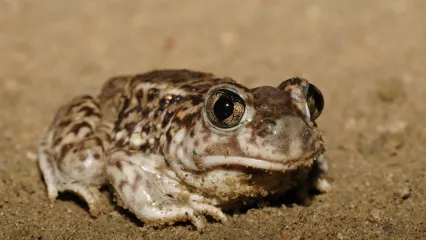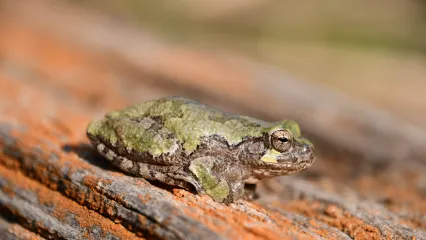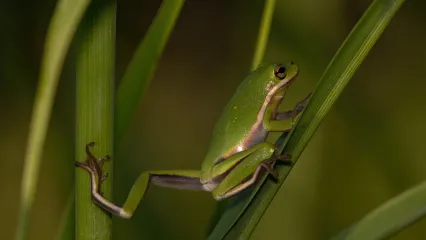
Description
Plains spadefoots are common but rarely seen unless conditions are suitable. Their skin is brown, greenish, or gray with scattered blotches or spots of the same but darker color. Some individuals can have tiny reddish spots within these spots or blotches. A distinguishing character is a bony lump between the eyes, called a “boss.” Unlike most other frogs, the pupil is vertical. Spadefoots get their name from a small, black wedge-shaped spade on the hindfoot, used for digging.
Plains spadefoot tadpoles are deep-bodied, robust, and are light brown to brown. The fins are clear with some irregular spotting. An unusual aspect of the biology of these tadpoles is that some individuals may develop a specialized morphology and become carnivorous. These individuals become much larger and develop serrations on their mouthparts, enabling them to catch and kill invertebrates such as fairy shrimp and smaller tadpoles, even those of the same species. The carnivorous form is triggered by drying ponds and ingestion of fairy shrimp.
The calls of Plains spadefoots are heard only after heavy rains in late spring and early summer. An individual call sounds like a low snore, but a large chorus of frogs makes a loud din that can be heard for a long distance.
Size
Plains spadefoots are medium-sized frogs, from 1.5 to 2.0 inches in length.
Habitat
In Oklahoma, this species occurs throughout the state, except in the northeast and southeast counties. The Plains spadefoot occurs throughout the Central Plains in the United States, extending into Mexico and Canada.
Life Cycle
Plains spadefoots are explosive breeders, emerging from underground refugia only after heavy rains. In dry years, they may remain underground and fail to breed. After a heavy rain, large choruses of these frogs form in roadside ditches, temporary rain pools, or other newly-formed ponds. Males call continuously for several days and amplexing pairs are common. This species engage in “scramble competition,” in which males call and swim about in the pond. When males encounter an amplexing pair, they try to dislodge the amplexing male from the female. Usually, the largest males win this competition and smaller males do not breed. The eggs hatch within a day and the tadpoles develop rapidly, metamorphosing within several weeks. If additional rain does not occur and the pond or ditch begins to dry, carnivorous morphs develop and consume the smaller tadpoles and insects, thereby ensuring that some individuals survive and transform into froglets.
Like most other frogs and toads, the Plains spadefoot feeds on small insects and spiders.
How To Observe
Plains spadefoots are difficult to observe because they come abroad only after heavy rains. Low, snoring sounds near recently formed ponds or roadside ditches indicate a breeding congregation. Breeding individuals are conspicuous as they swim about and call from the surface of the water.
(This profile was created by Dr. Laurie Vitt as part of a partnership between the Wildlife Department and the Sam Noble Oklahoma Museum of Natural History. It was funded as part of a larger State Wildlife Grant to survey and inventory amphibians and reptiles of the Wildlife Management Areas of Oklahoma: T-35-P-1.)


